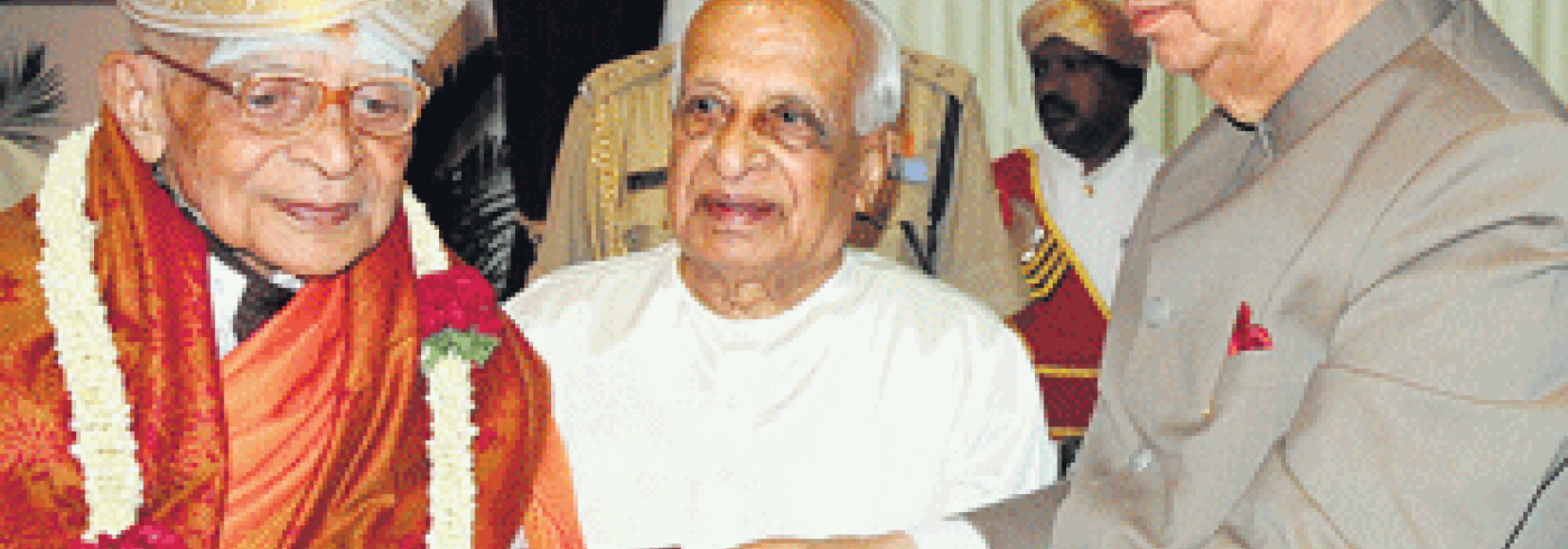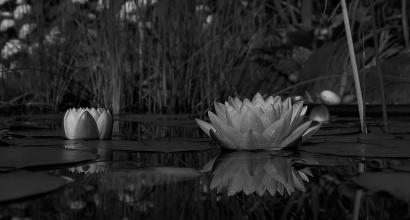Sense of Humour
Most of the time, Ranganatha Sharma’s mind was engaged in unknotting tough problems posed by the śāstras. But a sense of humour is something that came naturally to him. Whenever the occasion arose, he would laugh and make others around him laugh. I recollect a couple of such instances.
For some days, he resided quite close to the Gokhale Institute—just four streets behind the premises—in an out-house. One day, there was a certain ritual going on in his house – we heard an āhuti being offered to agni with the mantra – ‘agnaye svāhā.’ His son Nagabhushan, who was about four years old then, started mimicking the mantra and said, ‘Ajjaye svāhā[1]!’
The paṇḍita—i.e., Ranganatha Sharma—laughed and said, ‘Even while uttering something that his mouth can manage, the caturthī-vibhakti [2] is still in place!’
There were tens of such situations.
~
Ranganatha Sharma attended all programmes at the Gokhale Institute. One evening, when he visited the place, a music concert was going on.
I was standing by the gate and Sharma asked me – ‘A person who has no taste for music and literature is considered a cow without horns and tail[3], isn’t it?’
‘True, as per what you have taught us!’
‘In that case, a person who has taste for music and literature should be called a cow with tail and horns[4], isn’t it?’
~
One summer afternoon, Sharma came to see me in Chamarajpet. I asked him quite naturally, “Why have you come in the hot sun?”
He replied – “I did not come in host sun. I came and the hot sun also existed when I came.”
A certain person who was famous for his public discourses had the habit of amassing titles from different places. On top of it, he had made it a point to list them all one below the other wherever his name was printed. Looking at one such publication, Sharma called Śatāvadhāni Dr. R Ganesh and asked, “Have you noticed the number of titles this person has accumulated so far?” Ganesh replied, “Yes, I have counted them – twenty-eight in total!” Sharma corrected him, “You have counted wrong. There are twenty-nine in all. Check it once again!”
~
In 2011, when my book Dīptimantaru—a compilation of pen-portraits of renowned personalities—was published, I gave a copy to Sharma. While doing so, I mentioned that I had written about V S Kaushik, who was dear to both him and me. He laughed and said, “He is the teacher who taught me the use of naśya.”
~
In his old age, Sharma’s senses had weakened and even that was a matter of humour for him. At his age of ninety, he would say, “My eyes, ears, and other sense organs are telling me – You have retired from service thirty years back. Even then, you have put us to work all these thirty years. You never thought of giving any kind of rest to us. Therefore, we are now signing off from services to you!”
Authoring Works of Śāstra and Sāhitya
Sharma’s contribution to the world of knowledge is of great quality and quantity. He has authored eleven works in Sanskrit that include Śrī-śaṅkara-caritāmṛtam, Guru-paramparā-caritam, Bāḥubali-vijayam, and Ekacakram; over twenty works in Kannada that include Laukika-nyāyagaḻu, Śrī-rāmakathā-mañjarī, and Vyākaraṇaśāstrada parivāra; about five compilations such as Bhagavān-nāmāvaḻī. It is the translations and commentaries that Sharma has written that stand as his best contributions – Śrīmad-vālmīki-rāmāyaṇam, Śrīmad-bhāgavatam, Viṣṇu-purāṇam, Śaṅkara-digvijaya, Māṇḍūkya-pravacana, Taittirīyopaniṣat-pravacana, Pañcadaśī-pravacana, Amarakośa, Vākyapadīya, Śrīśāṅkarasūktimuktāvaḻī, and Śruti-sārasamuddharaṇa. Each one of these can be considered a peak in itself.
Though we will need to classify them under ‘translated works’, they are in fact independent works, for they are enriched by Sharma’s keen eye for subtle meanings. They are filled with the meaning, summary, essence, and notes wherever required and all these have come as a product of deep contemplation. Splitting of words, meaning of each, vigraha-vākya, formation of sentences, clarifications provided for doubts – these are the five features that can be invariably be found in his works. In addition to these, the insights he has provided as a result of his deep scholarship and vast experience can be seen in his writings. These works are crowning glories to his scholarship. They contain introductory portions filled with historical elements and objective analysis.
If enthusiasts of vedānta read his three pravacanas with enough attention, then the main prameyas (axioms) of the subject will certainly be well understood by them. He has rendered Bhartṛhari’s Vākyapadīya – a work which even the experts in śāstras find difficult to understand – in Kannada along with explanatory notes. The work Kāla mattu kriyè, a segment of his Vākyapadīyam, works with a bigger canvas and contains hitherto unseen philosophical deliberations.
Sharma has rendered Vyāsa-tātparya-nirṇaya in Kannada, a work that was largely unfamiliar even in the scholarly circles. It is a work that provides arguments to bolster the advaita tradition and is a composition of Ayyaṇṇa Dīkṣita, a scholar from the eighteenth century CE. Such a work can only be undertaken by a person who has a thorough and deep understanding of the vedāntic tradition.
Sharma not only had deep reverence for the scholars of the vedānta-śāstra but also held all experiential saints in high regard. He has composed biographical works of Siddhārūḍha-svāmī of Hubballi and Śrīdhara-svāmī of Varadahalli with utmost reverence and attention to detail. These works are inspiring and ennobling.
Beauty in Writing
Excellent scholarship, impactful expression while speaking from the dais, and a great writing style – these three qualities are rare to be found together in traditional scholars. Everyone who delivers public lectures is not necessarily a good writer. Similarly, scholars who can write well often cannot capture an audience while speaking. Sharma had developed a neat, coherent, lucid, powerful, and an attractive style of writing. His translated works and independent writings stand as great examples for a remarkable writing style in Hosagannaḍa.
During 1964–74, Sharma was motivated by DVG to translate the entire Vālmīki Rāmāyaṇa into Kannada. His translation, in a sense, stands as a testimony to his immense scholarship, and it is through this work that his scholarship was largely noticed by the Kannada world. Even today (i.e., in 2020), after half a century of its publication, these translated works have remained the favourite of the public at large. Though there have been other Kannada translations of Rāmāyaṇa that have appeared before and after the publication of his translation, even today, it is Ranganatha Sharma’s work that is readily accessible, especially because of its lucidity and thoroughness.
It was DVG who was responsible for initiating this mammoth project. It was he who made Sharma take up the task of translating. It was DVG yet again who arranged for the publication of the work through the Ramamandiram Association of Narasimha Raja Colony (in Bengaluru). He monitored the progress of the work and provided timely suggestions and guidance. Though he was close to eighty by then, DVG wrote detailed Forewords to each volume translated by Sharma – and this stands as a testimony to his deep-rooted interest in the work and the immense trust he had reposed in Sharma. It is also an attestation to the fact that Sharma never let down DVG’s trust in him.
Samarpaṇa-manobhāva (Attitude of Submission)
One of the main reasons for Sharma’s translation of the Rāmāyaṇa to capture the hearts of people is that it is not merely based on words and their meanings – it is a product of deep, independent thinking and his thorough study of various commentaries on the epic.
The Rāmāyaṇa was not just a work of poetry for Sharma. It had occupied his mental and emotional landscapes completely. During the days when he was preparing his translation, if one of us happened to visit him, he would make time to talk to us about the beauty of a verse that had just occurred to his mind.
He was so involved in the work that when he finished the translation of the Uttarakāṇḍa of the Rāmāyaṇa, he said with agony, “Ayyo! I caused Sītā-viyoga (Sītā’s agony due to separation from Rāma) to happen with my own hands!” He said this like he was solely responsible for the event!
Sharma’s efficiency at work was extraordinary. While he was translating the Rāmāyaṇa, he had quite a few responsibilities to fulfil at the Sanskrit College. He had to spend at least four hours everyday teaching subjects that required a lot of intellectual involvement. After finishing his teaching responsibilities for the day, he would take up the task of working on the translation.
~
Sharma served as a faculty at the Cāmarājendra Saṃskṛta Mahāpāṭhaśālā for twenty-eight years. He considered his time there as a sacred yajña – the very task of teaching students at different levels—primary and advanced—was an auspicious activity for him. His teaching was never limited to the prescribed syllabus. Sharma had devoted himself to the cause of enriching the knowledge and skill of the students. All his students fondly recollect his method of teaching, its coherence, clarity, and wholesomeness even to this day. He never slackened his thoroughness and ethical outlook in teaching, examining, and evaluating students. Magnanimity and adherence to ethical norms were blended in him in a hitherto unseen manner.
To be continued...
The current article is an English adaptation of the Kannada original which has appeared in the Dīptaśṛṅgagalu, authored by Nadoja Dr. S R Ramaswamy. Thanks to Sri Hari Ravikumar for his edits. Full form of the article is a part of 'A Tapestry of Pen Portraits' published by Prekshaa Pratishtana in December 2020.
Footnotes
[1] The ‘e’ at the end of ‘agnaye’ and ‘ajjaye’ captures the dative case. Sharma’s little son had captured the dative ending appropriately, though his pronunciation of the noun was flawed
[2] The fourth grammatical case of a noun – the dative
[3] An allusion to the famous saying in Sanskrit - sāhitya-saṅgīta-kalā-vihīnaḥ, sākṣat paśuḥ pucchaviṣāṇahīnaḥ
[4] sākṣāt paśuḥ pucchaviṣāṇayuktaḥ - words of Ranganatha Sharma, as quoted by the author.











































